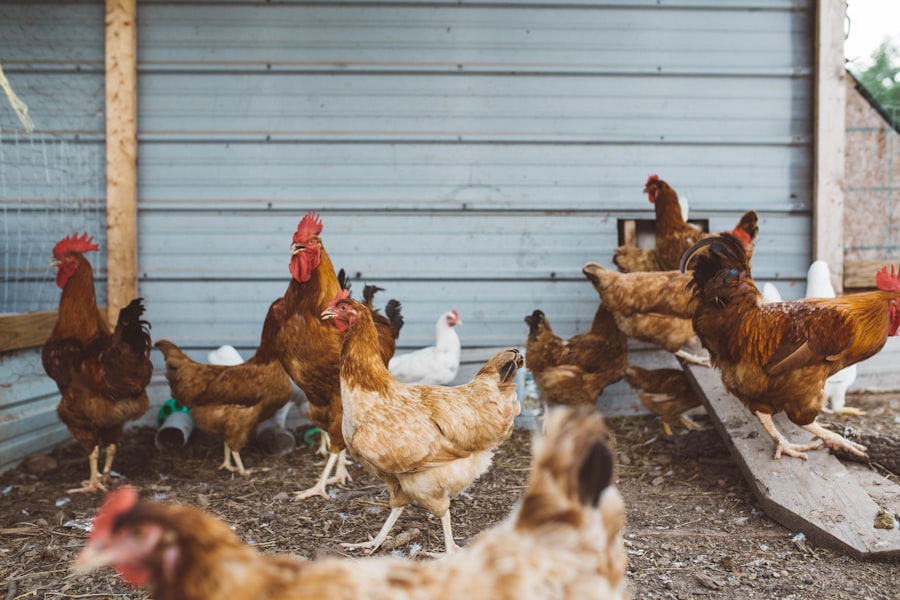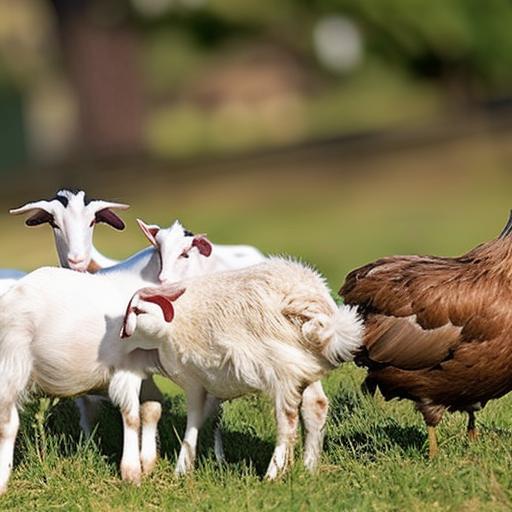Keeping goats and chickens together can be a rewarding and efficient way to raise livestock. Not only do these animals provide valuable resources such as milk, eggs, and meat, but they also offer natural pest control and help to maintain a healthy ecosystem. However, there are also challenges that come with raising goats and chickens together, such as potential aggression between the animals and different housing and feeding requirements. In this article, we will explore the benefits and drawbacks of raising goats and chickens together, as well as provide tips for successful integration and management of a mixed flock.
Personally, I have had experience with keeping goats and chickens together on my farm. I found that they complemented each other well and created a harmonious environment. The goats would graze on the pasture, keeping the grass short and reducing the risk of fire hazards. The chickens would follow behind the goats, pecking at insects and parasites in the soil. This symbiotic relationship not only benefited the animals but also improved the overall health of the land.
Key Takeaways
- Keeping goats and chickens together can be a great way to maximize space and resources on a small farm or homestead.
- Benefits of raising goats and chickens together include pest control, manure management, and companionship.
- Understanding the social dynamics of goats and chickens is important to ensure a harmonious flock.
- Housing requirements for mixed flocks should include separate sleeping areas and adequate space for both species.
- Feeding and nutrition considerations for mixed flocks should take into account the different dietary needs of goats and chickens.
Benefits and Drawbacks of Raising Goats and Chickens Together
There are several benefits to raising goats and chickens together. One of the main advantages is natural pest control. Chickens are excellent at foraging for insects, ticks, and other pests that can harm goats. By allowing chickens to roam freely in the same space as goats, you can reduce the need for chemical pesticides or other pest control methods.
Another benefit is efficient use of space. Goats require a significant amount of grazing area, while chickens can thrive in smaller spaces. By combining these two animals, you can maximize the use of your land and ensure that it is being utilized effectively.
Additionally, goats and chickens have complementary diets. Goats are browsers and prefer to eat leaves, shrubs, and weeds, while chickens are omnivores and eat a variety of grains, seeds, insects, and vegetation. By allowing them to graze together, they can help each other find a diverse range of food sources, resulting in a more balanced diet for both animals.
However, there are also drawbacks to raising goats and chickens together. One potential challenge is aggression between the animals. Goats can be territorial and may exhibit aggressive behavior towards chickens, especially if they feel threatened or if resources such as food or water are limited. It is important to closely monitor the interactions between the animals and take steps to prevent aggression.
Another challenge is the different housing and feeding requirements of goats and chickens. Goats require sturdy fencing to contain them, as they are known for their ability to escape. They also need shelter from extreme weather conditions and a separate area for kidding. Chickens, on the other hand, require a secure coop with nesting boxes and perches. They also need protection from predators such as foxes, raccoons, and hawks.
Understanding the Social Dynamics of Goats and Chickens
In order to successfully raise goats and chickens together, it is important to understand how these animals interact with each other. Goats are herd animals and have a hierarchical social structure. They establish a pecking order within the herd, with dominant goats asserting their authority over subordinate ones. Chickens also have a pecking order within their flock, with dominant birds asserting their dominance over others.
When introducing goats and chickens, it is important to monitor their interactions closely. Signs of aggression in goats include head-butting, charging, or chasing chickens. Signs of aggression in chickens include pecking or chasing goats. If you notice any aggressive behavior, it is important to intervene and separate the animals before any harm is done.
To prevent aggression between goats and chickens, it is recommended to introduce them gradually. Start by allowing them to see each other through a fence or wire mesh for a few days. This will allow them to become familiar with each other’s presence without direct contact. After a few days, you can try allowing them to interact in a supervised setting. If any aggression occurs, separate the animals and try again at a later time.
Housing Requirements for Goats and Chickens in the Same Space
When it comes to housing goats and chickens together, there are several options that work well for mixed flocks. One option is to provide separate housing for each species within the same area. This can be done by dividing a larger barn or shed into two sections, one for goats and one for chickens. Each section should have its own entrance, feeding area, and nesting boxes.
Another option is to provide a shared space for both goats and chickens. This can be done by creating a large fenced-in area where both species can roam freely. Within this space, you can provide separate shelters for each species, such as a small goat house and a chicken coop. It is important to ensure that the shelters are secure and provide protection from predators.
When designing housing for mixed flocks, it is important to consider the specific needs of each species. Goats require sturdy fencing that is at least four feet high to prevent them from escaping. They also need shelter from extreme weather conditions, such as a three-sided shed with a roof. Chickens require a secure coop with nesting boxes, perches, and adequate ventilation.
Feeding and Nutrition Considerations for Mixed Flocks
Feeding and nutrition is an important aspect of raising goats and chickens together. While goats are browsers and prefer to eat leaves, shrubs, and weeds, chickens are omnivores and eat a variety of grains, seeds, insects, and vegetation.
To provide a balanced diet for both animals, it is important to offer a variety of food sources. For goats, this can include pasture grasses, hay, browse (such as leaves and shrubs), and a small amount of grain or pellets. For chickens, this can include a commercial feed that is specifically formulated for laying hens, as well as kitchen scraps, insects, and vegetation.
It is important to ensure that both goats and chickens have access to fresh water at all times. This can be provided through separate water sources, such as buckets or troughs. It is also important to monitor the feeding habits of each animal and make adjustments as needed. For example, if a goat is consuming too much grain and not enough forage, you may need to reduce the amount of grain and increase the amount of forage in their diet.
Health and Disease Management for Goats and Chickens

When raising goats and chickens together, it is important to be aware of common health issues that can affect both species. Goats are susceptible to diseases such as pneumonia, parasites (such as worms), and foot rot. Chickens are susceptible to diseases such as respiratory infections, parasites (such as mites or lice), and egg-related issues.
To prevent and treat diseases in a mixed flock, it is important to practice good biosecurity measures. This includes keeping the living areas clean and free from feces, providing regular veterinary care, and monitoring the health of each animal. It is also important to quarantine any new animals before introducing them to the flock to prevent the spread of disease.
Predation Risks and How to Protect Your Flock
When raising goats and chickens together, it is important to be aware of the predation risks that both species face. Goats are vulnerable to predators such as coyotes, dogs, and mountain lions. Chickens are vulnerable to predators such as foxes, raccoons, hawks, and snakes.
To protect your flock from predators, it is important to provide secure fencing around the perimeter of the area where they are kept. This can include sturdy wire mesh or electric fencing. It is also important to provide secure housing for both goats and chickens, such as a sturdy barn or coop with locks on the doors and windows.
Additionally, it is important to be vigilant and monitor the area for signs of predators. This can include tracks, droppings, or evidence of digging or scratching. If you notice any signs of predators, it is important to take immediate action to protect your flock.
Tips for Successful Integration of Goats and Chickens
Integrating goats and chickens into the same space can be a challenging process, but with proper planning and management, it can be successful. Here are some tips for successful integration:
1. Introduce new animals gradually: Start by allowing them to see each other through a fence or wire mesh for a few days. This will allow them to become familiar with each other’s presence without direct contact.
2. Provide separate feeding areas: Goats and chickens have different feeding habits and requirements. By providing separate feeding areas, you can ensure that each animal has access to the appropriate food sources.
3. Monitor interactions closely: Watch for signs of aggression or stress in both goats and chickens. If any aggression occurs, separate the animals and try again at a later time.
4. Establish a pecking order: Both goats and chickens have a hierarchical social structure. Allow them to establish their own pecking order within the flock, but intervene if any aggression becomes excessive or harmful.
5. Provide plenty of space: Both goats and chickens require space to roam and graze. Make sure that the area where they are kept is large enough to accommodate their needs.
Common Challenges and How to Overcome Them
Raising goats and chickens together can come with its fair share of challenges. One common challenge is dealing with noise and odor. Goats can be quite vocal, especially during breeding season or when they are in distress. Chickens can also be noisy, especially when they are laying eggs or when they feel threatened. To minimize noise and odor, it is important to provide adequate space and ventilation for both animals. Regular cleaning of the living areas can also help to reduce odor.
Another challenge is managing waste and keeping the coop clean. Both goats and chickens produce waste, which can accumulate quickly if not properly managed. It is important to regularly clean the living areas and remove any waste to prevent the spread of disease and pests. Composting the waste can also be a beneficial way to recycle nutrients and improve soil health.
Is Keeping Goats and Chickens Together Right for You?
In conclusion, keeping goats and chickens together can be a rewarding and efficient way to raise livestock. The benefits of natural pest control, efficient use of space, and complementary diets make it an attractive option for many farmers and homesteaders. However, there are also challenges that come with raising goats and chickens together, such as potential aggression between the animals and different housing and feeding requirements.
Before starting a mixed flock, it is important to carefully consider the specific needs of both goats and chickens, as well as your own resources and capabilities. It is also important to have a plan in place for managing aggression, providing appropriate housing and feeding, and preventing and treating diseases.
Based on my personal experience, I would recommend keeping goats and chickens together if you have the necessary resources and are willing to put in the time and effort required for successful integration and management. With proper planning and management, a mixed flock can provide numerous benefits and create a harmonious environment for both animals.
If you’re considering keeping goats with chickens, it’s important to understand the dynamics and potential challenges of this combination. To learn more about successfully cohabitating these two animals, check out this informative article on Poultry Wizard: “Turning a Shed into a Chicken Coop”. This article provides valuable insights and practical tips on creating a suitable living environment for your chickens while accommodating goats in the same space. It covers important considerations such as space requirements, feeding arrangements, and overall management to ensure the well-being of both species.
FAQs
What are the benefits of keeping goats and chickens together?
Keeping goats and chickens together can provide a variety of benefits. Goats can help control weeds and brush, while chickens can help control insects and provide fertilizer for the goats. Additionally, both animals can provide a source of food and income for their owners.
What are the potential problems of keeping goats and chickens together?
One potential problem of keeping goats and chickens together is that goats may try to eat chicken feed, which can lead to nutritional imbalances for both animals. Additionally, goats may accidentally injure or kill chickens if they become too rough during play or if they feel threatened.
What should be considered when planning to keep goats and chickens together?
When planning to keep goats and chickens together, it is important to consider the size of the animals and the amount of space they will need. Additionally, it is important to provide separate feeding areas for the goats and chickens to prevent competition for food. Finally, it is important to monitor the animals closely to ensure that they are getting along and that there are no signs of aggression or injury.
What are some tips for keeping goats and chickens together?
Some tips for keeping goats and chickens together include providing separate feeding areas, providing plenty of space for both animals, and monitoring the animals closely for signs of aggression or injury. Additionally, it may be helpful to provide separate housing areas for the animals to prevent them from getting too close to each other.
Can goats and chickens be kept together in the same enclosure?
Yes, goats and chickens can be kept together in the same enclosure, but it is important to provide plenty of space and separate feeding areas to prevent competition for food. Additionally, it is important to monitor the animals closely to ensure that they are getting along and that there are no signs of aggression or injury.
Meet Walter, the feathered-friend fanatic of Florida! Nestled in the sunshine state, Walter struts through life with his feathered companions, clucking his way to happiness. With a coop that’s fancier than a five-star hotel, he’s the Don Juan of the chicken world. When he’s not teaching his hens to do the cha-cha, you’ll find him in a heated debate with his prized rooster, Sir Clucks-a-Lot. Walter’s poultry passion is no yolk; he’s the sunny-side-up guy you never knew you needed in your flock of friends!







